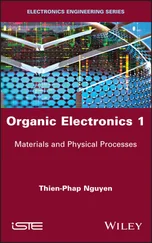1 ...8 9 10 12 13 14 ...20 21 21 Li, W., Ning, J., Yin, Y. et al. (2018). Thieno[3,2‐b]thiophene‐based conjugated copolymers for solution‐processable neutral black electrochromism. Polymer Chemistry 9 (47): 5608–5616.
22 22 Beaujuge, P.M. and Reynolds, J.R. (2010). Color control in π‐conjugated organic polymers for use in electrochromic devices. Chemical Reviews 110 (1): 268–320.
23 23 Jiang, M., Sun, Y., Ning, J. et al. (2020). Diphenyl sulfone based multicolored cathodically coloring electrochromic materials with high contrast. Organic Electronics 83: 105741.
24 24 Fred Schubert, E., Chapter 16. Human Eye Sensitivity and Photometric Quantities in Light‐Emitting Diodes, 2e. Cambridge University Press.
25 25 Kraft, A. (2018). Electrochromism: a fascinating branch of electrochemistry. ChemTexts 5 (1): 1–18.
26 26 Padilla, J., Seshadri, V., Filloramo, J. et al. (2007). High contrast solid‐state electrochromic devices from substituted 3,4‐propylenedioxythiophenes using the dual conjugated polymer approach. Synthetic Metals 157 (6–7): 261–268.
27 27 Hsiao, S.‐H. and Lin, S.‐W. (2016). Electrochemical synthesis of electrochromic polycarbazole films from N‐phenyl‐3,6‐bis(N‐carbazolyl)carbazoles. Polymer Chemistry 7 (1): 198–211.
28 28 Hassab, S., Shen, D.E., Österholm, A.M. et al. (2018). A new standard method to calculate electrochromic switching time. Solar Energy Materials and Solar Cells 185: 54–60. https://doi.org/10.1016/j.solmat.2018.04.031.
29 29 Fabretto, M., Vaithianathan, T., Hall, C. et al. (2008). Faradaic charge corrected colouration efficiency measurements for electrochromic devices. Electrochimica Acta 53 (5): 2250–2257.
30 30 Wei, Y., Zhou, J., Zheng, J., and Xu, C. (2015). Improved stability of electrochromic devices using Ti‐doped V2O5 film. Electrochimica Acta 166: 277–284.
31 31 Lampert, C.M., Agrawal, A., Baertlien, C., and Nagai, J. (1999). Durability evaluation of electrochromic devices – an industry perspective. Solar Energy Materials and Solar Cells 56 (3): 449–463.
2 Advances in Polymer Electrolytes for Electrochromic Applications
2.1 Introduction
The ionic conduction medium between the electrodes and electrochromic (EC) materials is an electrolyte, which is one of the most essential active components in electrochromic device (ECD). Electrolyte provides an indispensable role as the prime ionic conduction medium between the electrodes while preventing electron conduction between the two electrodes during EC operation. The important electrolyte properties greatly affecting the EC performance are the electrolyte ionic conductivity, ion dissociation, transport rate of ion through bulk and interface, and thermal stability [1]. Electrolytes were initially reported in the early 1970s, including ceramic, glass, crystalline, and polymer electrolytes (PEs). PE was first introduced by Fenton et al. in 1973 [2] and widely applied since 1980s [3]. In the past decades, PEs attracted much attention from all over the world's researchers due to their promising applications in electrochemical storage/conversion devices.
In general, electrolytes can be classified into PEs, liquid electrolytes, ceramic electrolytes, and solid inorganic electrolytes [4–6]. Briefly, PE is a membrane composed of a dissolution of salts in a polymer matrix with high molecular weight [7]. PE is widely applied in electrochemical devices such as solid‐state batteries and rechargeable batteries, ECDs, supercapacitors, fuel cells, dye‐sensitized solar cells, and EC windows. Technologically, PEs evolved from polymer, liquid ionic conductor and solid‐state ionic conductor. PEs can be prepared by dissolving metal salts in polar polymer hosts, which could be used to replace the liquid ionic solution. Liquid electrolytes possessing high ionic conductivity have several inevitable drawbacks such as the possibility of electrolyte leakage, low chemical stability, hydrostatic pressure considerations, and difficulty in assured sealing and are unsafe for practical applications especially in scaling‐up processes [8]. Comparing with liquid electrolytes, PE has several prominent advantages, such as high ionic conductivity, safety, flexibility, wide electrochemical windows, and so on [9, 10].
2.2 Requirements of Polymer Electrolytes in Electrochromic Applications
Factors that lead to the use of PE in an EC devices are as follows ( Figure 2.1).
High optical transparencyHigh optical transparent PEs are highly desirable for EC applications. High transmittance enhances the transparency of an EC device in the bleached state. Electrolytes cannot affect the optical shifts during colored and bleached states.
Flexible and mechanically stretchablePE owing to flexible and mechanically stretchable advantages can be better applied in ECDs, especially in flexible and stretchable devices. The polymeric matrix is of vital importance. The PE requires to keep mechanical stability during bending and stretching states.
Multifunctional separatorThere is a direct contact between the two electrodes without any separator, which will lead to a short circuit. PE can act as a separator layer in an EC device, making these devices light and compact without the need for additional separators. Moreover, PEs demand intimate binding effect, making favorable electrical contact with the electrodes and good adherence to EC layers.
Wide range of working temperaturePEs inherently exhibit the ability to operate over a wide range of temperature as compared to the other counterparts.
Cation coordination abilityPolymers in electrolytes with benign cation coordination ability can better make for coordination bonding interactions with the metal cations.
Wide operation potential windowStable electrochemical window is the range of working potential in an EC device without breakdown of electrolyte itself. The maximum potential is determined by the potential of the oxidation reaction. Meanwhile, the minimum potential is determined by the potential of the reduction reaction. To ensure the long‐time and cycling stability of the ECD, the working potential window of a device should be considered in the electrochemical operating range of the electrolyte.
Thermal, photo, chemical, and electrochemical stabilityAn ideal PE should possess good thermal and photo stability. During electro chromic processes, the device may release heat, which may result in degradation of the EC devices. Similarly, an ideal electrolyte with photo stability prevents device from being destroyed via prolonged exposure to air. It is necessary to keep good electrochemical stability in the voltage range for ECDs. Undesired interaction effects between the EC layer and electrolyte should not exist in the ECD during EC processes so that devices can keep reversible and long lifetime performance for practical application. This chemical stability must be ensured both during the deposition and during the cycling processes. Currently, small molecule EC materials‐based ECDs have appeared in lots of researches. However, this kind of ECD mostly can be operated under higher potential. Therefore, PEs with wide potential window are demanded.
High ionic conductivity (>10−4 S/cm) with low electronic conductivityPEs should be a good ionic conductor and electronically insulating (σe < 10−12 S/cm) so that ion transport could be facilitated to minimize self‐discharge. In EC process, the essence of color change is the transfer of ions into and out of an EC film. The electrolyte should also maintain its high ionic conductivity even after thousands of cycles. The flexibility of polymer matrix chains in the amorphous phase allows ions to be transported frequently. This easy transport of ions is hindered in the crystalline phase, where the material is densely packed and there is not enough space to allow rapid transport of ions [11]. The ion transference number is important in the characterization of PEs. A large transference number can reduce concentration polarization of electrolytes during charge–discharge steps [12].
Читать дальше












